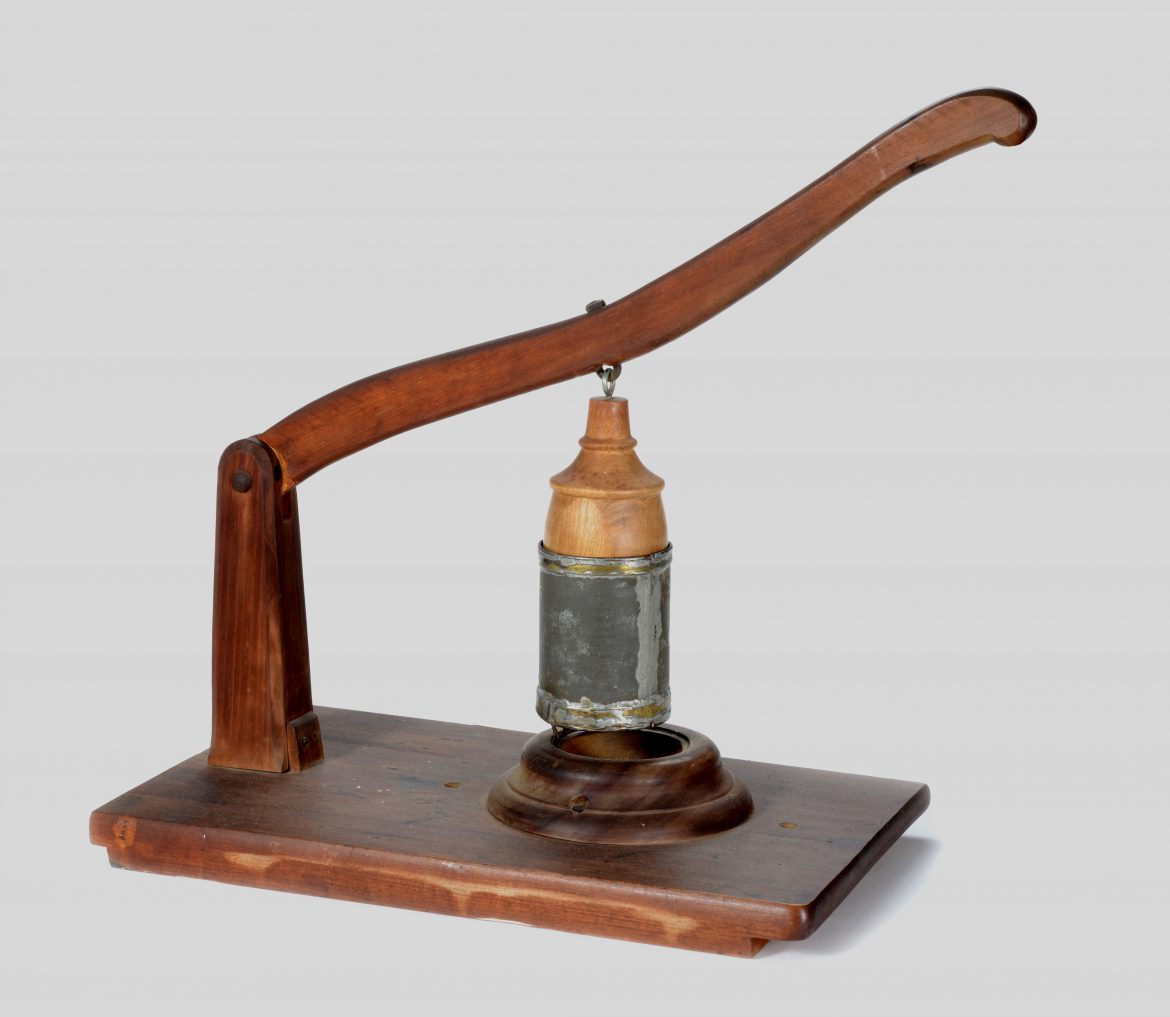
Popcorn Ball Press and Accessories, Church Family, Canterbury, NH, Ca. 1885, Shaker Museum | Mount Lebanon, 1953.6589.1 (press) and 1953.6590.1-.3 (cylinders)
Shaping popcorn into balls when it is covered in hot sugar syrup or molasses is hard on the hands, especially in quantity. This popcorn ball press relieved that discomfort and made consistently sized balls. Using the press was pretty simple – the metal cylinders were filled with sticky popcorn and then placed on the base […]

Popcorn Ball Press and Accessories, Church Family, Canterbury, NH, Ca. 1885, Shaker Museum | Mount Lebanon, 1953.6589.1 (press) and 1953.6590.1-.3 (cylinders)
Shaping popcorn into balls when it is covered in hot sugar syrup or molasses is hard on the hands, especially in quantity. This popcorn ball press relieved that discomfort and made consistently sized balls.
Using the press was pretty simple – the metal cylinders were filled with sticky popcorn and then placed on the base of the press. The arm was pushed down until the two recesses met, trapping a perfectly round ball between them. The finished popcorn balls were then either served or wrapped in cellophane or waxed paper to be eaten or sold later. Though there’s no documentation of the Shakers selling popcorn balls, the three accompanying metal cylinders suggest a vigorous production.
The Museum’s 1953 accession records for the popcorn ball press provide two significant pieces of information: That the press was made by Canterbury Brother Alexander Cochran (sometimes Cochrane), and that it was used for making “molasses popcorn balls.” Brother Alexander Y. Cochran was born May 14, 1848. Much of Brother Alexander’s life story eludes us, but we know he was the natural brother of Eldress Dorothea T. Cochran at Canterbury. Eldress Dorothea was born in 1844 in Duntalker, Scotland. While the 1860 census gives Alexander’s birthplace as Massachusetts, it is likely his parents came to this country between 1844 and 1848. Brother Alexander was second elder in the Canterbury Church Family and worked closely with Ministry Elder Henry Blinn on managing correspondence and financial matters pertaining to the publication of the Manifesto up until May, 1890, when he decided to leave the Shakers. Little more is known about his post-Shaker life, except that an Alexander Y. Cochrane of Waverly, Massachusetts, was granted patent 584,922 on July 22, 1897 for an improvement in a “yielding wire seat frame” and that he was, in 1920, married to Louise F. Cochrane. Among Eldress Dorothy’s vital statistics it is recorded that she had a brother living in Waverly, Massachusetts, so it’s likely this is the same Alexander Cochran. We don’t know whether the popcorn ball press was a harbinger of Brother Alexander’s inventive nature, but his departure from the Shakers in 1890 does provide a date before which the press was made and used.
There are two scenarios for the Canterbury Shakers popcorn ball adventures – one, that they made traditional blackstrap molasses popcorn balls and the second, that molasses, in this case, refers to maple molasses. Any readers with special knowledge of the history of popcorn balls in New England are encouraged to weigh in.
Maple Molasses: About two miles from the Shaker Village at Canterbury, the Shakers had an 800-tree sugar bush that they tapped for over a half a century. The trees produced over 50 barrels of sap per day during sugaring season and the sugar house workers could turn that into 50 gallons of syrup or 350 pounds of maple sugar. The Canterbury sisters made a variety of maple candies to sell from the sugar and it is reasonable to think that maple molasses popcorn balls may have been among their offerings for sale. A simple recipe for maple molasses popcorn balls can be found at here.
Blackstrap Molasses: In the 1880s the cane sugar and molasses jockeyed for position as the more expensive sweetener. Cane sugar had historically been the more expensive of the two, but as improvements in processing sugar cane were made it eventually became quite inexpensive and a premium emerged for those who preferred the taste of blackstrap molasses. If you have not tasted molasses popcorn, think Cracker Jacks, America’s first “The More You Eat the More You Want” junk food. Its flavor is an acquired taste (and today’s corn syrup Cracker Jacks do not do the original justice), but apparently once a devotee, it was greatly preferred by some in some foods – popcorn balls being one of them. There are a number of recipes available for making molasses popcorn balls. One five-star recipe for “bare-bones popcorn balls” that uses just popped corn, molasses, and refined sugar can be found here. The final step in this recipe is to “eat whatever sticks to your fingers.” Bon appetit!

Molasses Popcorn Balls from Tori Avey: Tori’s Kitchen website.